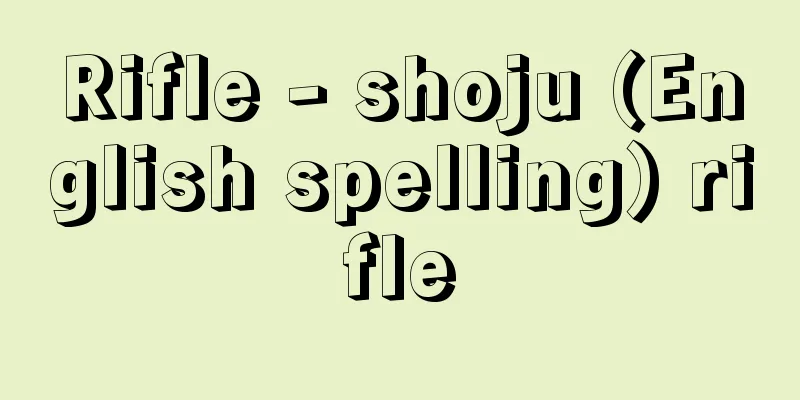Rifle - shoju (English spelling) rifle

|
A general term for military portable firearms with a caliber of 12.5 mm or less. It generally refers to a gun that is held in both hands and fires a single bullet. Guns that fire multiple small bullets at the same time are called shotguns to distinguish them. Military guns for infantry use were originally called rifles, but rifles used for sports shooting such as hunting are also called hunting rifles. [Masami Tokoi] History of the Development of RiflesThe English name "rifle" comes from the spiral grooves (rifling) cut into the inside of the barrel to ensure bullet accuracy. In Germany and other countries, rifles equipped with spiral barrels, called "Jäger-Buchse," were issued to military snipers from an early stage, but rifles with spiral barrels did not become widespread among ordinary infantry soldiers until around the 18th century, when the percussion lock firing mechanism was adopted. Rifles before that were called muskets or dragoons depending on their length. Rifles were originally sniper weapons used by military personnel for personal armament, and fired bullets with a core of heavy metal such as lead. Until the mid-19th century, muzzle-loading single-shot guns, in which bullets and propellant were loaded from the muzzle, were the norm. In the mid-19th century, with the invention of cartridges that combined the bullet and the primer to ignite the propellant, breech-loading guns, in which ammunition was loaded from the rear end of the barrel, became common. European countries and the United States began to use repeating rifles for military use at the end of the 19th century. At first, they were impractical because they used black powder as propellant, but the invention of smokeless powder led to improvements in ammunition and made them more practical. Repeating rifles were mainly made up of the Mauser bolt-action rifle, developed by von Paul Mauser of Germany. The bolt-action rifle was adopted by many countries and was used as the main infantry weapon until the end of World War II. In the 1930s, Germany, the United States, the former Soviet Union and other countries researched self-loading rifles, and some of these products were used in World War II. At the end of World War II, Germany deployed assault rifles (Stümgewehr/assault rifles) to the front lines, using small, short ammunition and capable of semi-automatic as well as full-automatic continuous firing. Since assault rifles can fire a large number of bullets and have high enemy suppression power, they became the mainstream military rifle in armies around the world after World War II. The Type 64 rifle and Type 89 rifle, which are currently selected and used by the Japanese Self-Defense Forces, are also products that belong to the assault rifle category. The performance of a rifle is largely determined by the ammunition used. Rifles have used black powder for a long time since the development of firearms. Because of its characteristics, black powder makes it difficult to give a bullet high velocity, so in order to gain power, large, heavy lead bullets with a diameter of nearly 20 mm were fired. With the improvement of gunpowder in the 18th century, and the invention of smokeless powder, bullets became revolutionarily small and light. Bullets, which had been large and heavy up until then, became lighter with a diameter of around 8 mm thanks to the invention of smokeless powder. Some countries adopted even smaller bullets of 7 mm or 6.5 mm in diameter. Various diameters of bullets were tried in each country, but later, the need arose for special ammunition such as tracer bullets, incendiary bullets, and explosive bullets. Since small calibers were difficult to manufacture, the diameter settled on around 7.5 to 8 mm by the time of World War II. During World War II, Germany and the United States developed short bullets that reduced the propellant and made it easier to control firing, and automatic rifles that used short bullets. After World War II, these short bullets, which were easier to control, became widely used as military ammunition. During the Vietnam War, the United States further developed short ammunition and established small-caliber, high-velocity ammunition, which fires a 5.56mm bullet at high speed, for military use. Small-caliber, high-velocity ammunition has less recoil, is lightweight, and allows large quantities of ammunition to be carried without increasing the burden on soldiers, so it became the mainstream of military ammunition thereafter. Currently, the United States and many Western European countries use 5.56mm ammunition as the latest military ammunition, while Russia and other countries use 5.45mm ammunition, and China uses 5.8mm ammunition. [Masami Tokoi] Representative riflesThere are many rifles that have been designed and manufactured in the past, but some of the modern rifles that represent the era include the following: The Snyder rifle (Britain), a breech-loading rifle modified from a muzzle-loading rifle; The Dreyse rifle (Germany), which became the prototype for the bolt-action rifle; The Winchester M1866 rifle (USA), a repeating lever-action rifle; The Mauser M1871 rifle (Germany), the first bolt-action rifle; The Mauser M1898 rifle (Germany), the most complete repeating bolt-action rifle, which was produced under license or copied in various countries; The M1 rifle (USA), a semi-automatic rifle used by the US military in World War II; and the MP44 (Germany), the first assault rifle. Representative products from after World War II include the following: the AK47 (Kalashnikov Automatic Model 1947) series, originally conceived by the former Soviet Union; the M16 rifle/AR15 rifle series (USA), equipped with a light alloy frame and using small-caliber, high-velocity ammunition; the G3 rifle (Germany), which has many variations; the FN rifle/FAL rifle (Belgium), which was exported to many countries; and the AUG rifle (Austria), which makes extensive use of plastic. Representative modern Japanese rifles include the first domestically produced bolt-action Murata rifle, the Type 13 Murata rifle, made in 1880 (Meiji 13), and the small-caliber bolt-action repeating Type 38 rifle (Type 38 infantry rifle), which was established in 1905 (Meiji 38) and became synonymous with rifles used by the former Imperial Japanese Army. After World War II, there was the Type 64 rifle, established in 1964 (Showa 39) for use by the Self-Defense Forces. The following are representative military rifles currently in use around the world: the American M16A2 rifle; the AK74 rifle, which uses small-caliber, high-velocity ammunition and is used in Russia and other former socialist countries; the small AUG rifle, developed in Austria and made with a lot of plastic; the Israeli Galil rifle, a modernized version of the AK47 rifle; the small FA and MAS rifles used by the French military; the German G36 rifle, which uses a lot of plastic; and the FNC rifle, originally designed by the Belgian FN company and used in Belgium, Sweden, Indonesia, and other countries. The Japanese Self-Defense Forces use the Type 89 rifle, which uses small-caliber, high-velocity ammunition and was established in 1989 (Heisei 1). For gun control laws, see the "Handguns" entry, and for gun sports, see the "Shooting Sports" and "Rifle Shooting" entries. [Masami Tokoi] [References] | | | | | | | | |[Bolt-action rifle] Mauser 98. The bolt, which is in line with the rear of the barrel, is manually rotated 90 degrees to raise it and move it back and forth to open and close the chamber and load and eject cartridges. [Automatic rifle] M16A1. When the bullet passes the gas port, combustion gas passes through the gas tube and pushes the bolt carrier backwards. The bolt carrier moves backwards along with the hammer, ejecting the empty cartridge. The buffer spring then moves the bolt carrier forward, sending the next cartridge into the chamber. The M16A1 can be switched between semi-automatic, which fires one shot at a time, and fully automatic, which fires continuously as long as the trigger is pulled, by using the switch lever on the left. ©Shogakukan "> Bolt-action and automatic rifle construction Source: Shogakukan Encyclopedia Nipponica About Encyclopedia Nipponica Information | Legend |
|
口径12.5ミリ以下の軍用携帯火器の総称。両手で保持し一発の弾丸を発射する銃一般をいう。多数の小さな弾丸を同時に発射するものは散弾銃(ショットガン)とよんで区別する。もともと歩兵用の軍用銃を小銃とよんでいたが、狩猟などのスポーツ射撃をするものも狩猟用小銃などとよぶ。 [床井雅美] 小銃の発展史英語の名称ライフルは、弾丸の命中精度を得るため銃身内部に切られた螺旋溝(らせんこう)(ライフリングrifling)に由来する。ドイツなどでは早い時期から軍の狙撃(そげき)兵に螺旋溝つき銃身を装備した小銃「イェーガー・ブクセ」を支給していたが、軍の一般的な歩兵に螺旋溝入りの小銃が普及するのは、パーカッションロック(管打(かんだ)式/雷管(らいかん)式撃発装置)の発火機構が採用された18世紀前後だった。それ以前の小銃は、長さによりマスケットやドラグーンなどとよばれていた。もともと小銃は軍隊の個人武装に用いられる狙撃用武器で、鉛など比重の大きな金属を芯(しん)にした弾丸を射撃する。 19世紀中ごろまで、銃口部から弾丸や発射薬を装填(そうてん)するマズルローダー(前装式/先込め式)の単発銃が主流だった。19世紀中ごろに弾丸と発射薬点火用の雷管を一体化した薬莢(やっきょう)が発明されると、銃身後端から弾薬を装填するブリーチローダー(後装式/元込め式)が一般的になる。 ヨーロッパ各国やアメリカは、19世紀末に連発式の小銃を軍用に制定して使用し始める。初め発射薬に黒色火薬を使用したため実用性が低かったが、無煙火薬の発明で弾薬が進歩し実用性を増大させた。 連発式小銃は、ドイツのフォン・パウル・マウザーが開発したマウザー・ボルトアクション小銃などが主流となった。ボルトアクション小銃は多くの国で採用され、第二次世界大戦の終結まで歩兵の主要な武装として用いられた。 1930年代にドイツ、アメリカ、旧ソ連などでは自動装填式の小銃が研究され、そのうちのいくつかの製品は第二次世界大戦で使用された。 第二次世界大戦末にドイツは、小型の短小弾薬を使用し、半自動連射だけでなく全自動連射も可能な突撃銃(スチュームゲベアー/アサルトライフル)を戦線に投入した。多数の弾丸を射撃でき敵制圧力の高い突撃銃は、第二次世界大戦後、世界中の軍隊の軍用小銃の主流となった。現在、日本の自衛隊に選定され使用されている64式小銃や、89式小銃も突撃銃のカテゴリーに属する製品である。 小銃の性能を大きく左右するのは使用する弾薬である。小銃は銃砲が開発されてから長く黒色火薬を使用した。黒色火薬は、その特性から弾丸に大きな速度を与えにくく、威力を得るため直径20ミリ近い大きく重い鉛の弾丸を発射していた。 18世紀に火薬の改良が進み、無煙火薬が発明されると、弾丸は革命的に小型・軽量になった。それまでの直径が大きく重かった弾丸は、無煙火薬の発明により直径が8ミリ前後になり軽量になった。国によっては、さらに小さな7ミリや6.5ミリの直径の弾丸も採用された。各国でさまざまな直径の弾丸が試されたものの、その後、曳光(えいこう)弾、焼夷(しょうい)弾、爆裂弾などの特殊弾薬の必要性が出て、小口径では製造がむずかしいところから第二次世界大戦になると直径7.5~8ミリ周辺に落ち着いた。第二次世界大戦中、ドイツやアメリカは、発射薬を減少させて射撃のコントロールを容易にした短小弾薬と、短小弾薬を使用する自動小銃を開発した。第二次世界大戦後、コントロールの容易なこの短小弾薬が軍用弾薬として多用されるようになった。 ベトナム戦争中にアメリカは短小弾薬をさらに発展させ、直径5.56ミリの弾丸を高速で発射する小口径高速弾薬を軍用に制定した。小口径高速弾薬は射撃の反動が少なく、軽量で兵士の負担を増すことなく大量の弾薬を運搬できる性格をもっているところから、その後の軍用弾薬の主流となった。現在、アメリカをはじめ西ヨーロッパの多くの国々は口径5.56ミリの弾薬、ロシアなどは口径5.45ミリの弾薬、中国は口径5.8ミリの弾薬を、それぞれ最新の軍用弾薬に制定している。 [床井雅美] 代表的な小銃過去設計製造された小銃は数多くあるが、時代を代表する近世のライフルとしては以下のようなものがある。前装式銃を改造した後装式のスナイダー銃(イギリス)。ボルトアクションの原型となったドライゼ銃(ドイツ)。レバーアクション連発式のウィンチェスターM1866ライフル(アメリカ)。最初のボルトアクション式マウザーM1871ライフル(ドイツ)。もっとも完成度の高い連発式ボルトアクション式で各国でライセンス生産やコピーされたマウザーM1898ライフル(ドイツ)。第二次世界大戦でアメリカ軍に使用されたセミオートマチックのM1ライフル(アメリカ)。最初の突撃銃であったMP44(ドイツ)など。 第二次世界大戦後の代表作としては以下のようなものがある。旧ソ連原案のAK47(カラシニコフ・オートマチック1947年型)シリーズ。軽合金フレーム装備で小口径高速弾薬を使用するM16ライフル/AR15ライフルシリーズ(アメリカ)。多くの発展型をもつG3ライフル(ドイツ)。多くの国に輸出されたFNライフル・FALライフル(ベルギー)。プラスチックを多用したAUGライフル(オーストリア)など。 近代日本の小銃の代表としては、1880年(明治13)の初の国産ボルトアクション式十三年式村田銃、1905年(明治38)に制定され旧日本陸軍使用銃の代名詞にもなった小口径ボルトアクション連発式の三八式小銃(三八式歩兵銃)がある。第二次世界大戦後では、自衛隊用として1964年(昭和39)に制定された64式小銃などがある。 現在、世界各国で使用されている軍用小銃の代表的なものは以下の銃である。アメリカのM16A2ライフル。ロシアをはじめ旧社会主義各国で使用されている小口径高速弾薬を使用するAK74ライフル。オーストリアで開発されたプラスチックを多用した小型のAUGライフル。AK47ライフルを近代化したイスラエルのガリル・ライフル。フランス軍が使用する小型のFAライフル・MASライフル。プラスチックを多用したドイツのG36ライフル。ベルギーやスウェーデン、インドネシアなどで使用されているベルギーFN社原案のFNCライフルなど。日本の自衛隊は、1989年(平成1)に制定された小口径高速弾を使う89式小銃を使用している。 なお、銃の規制に関する法律については「拳銃」の項目を、銃を用いた競技については「射撃競技」「ライフル射撃」の項目を参照。 [床井雅美] [参照項目] | | | | | | | | |【ボルトアクション小銃】マウザー98(モーゼル98)。バレル(銃身)後方一直線上にあるボルト(槓桿)を手動で90度回転して起こし、前後させることによって、チェンバー(薬室)の開閉とカートリッジの装填、排莢を行う。【自動小銃】M16A1。弾頭がガスポートを通過すると、燃焼ガスがガスチューブを通って、ボルトキャリアを後退させる。ボルトキャリアはハンマー(撃鉄)とともに後退し、空薬莢を排出する。その後、バッファースプリングによってボルトキャリアは前進し、次のカートリッジをチェンバーに送り込む。このM16A1は、左側の切り替えレバーによって1発ずつ撃つ半自動と、トリガー(引き金)を引いている間、撃ち続ける全自動が選べるようになっている©Shogakukan"> ボルトアクション小銃と自動小銃の構造 出典 小学館 日本大百科全書(ニッポニカ)日本大百科全書(ニッポニカ)について 情報 | 凡例 |
Recommend
Nagazuka (long handle) - Stichaeus grigorjewi
A marine fish of the family Tauegajidae (illustrat...
Oxenbury, H. - Oxenbury
…What is particularly noteworthy about the UK is ...
National Land Comprehensive Development
To comprehensively utilize, develop, and conserve...
Khwārazm Shāh
A dynasty centered on the Khwarezm region in the l...
Sekisansatsu - Observation
…In 1615 (Genwa 1), the Edo Shogunate issued the ...
Luminosity function
Let f ( M ) dM be the number of celestial objects ...
meuble
…One of the characteristics of medieval furniture...
Kan'ei culture
This culture was centered on the Kan'ei era (1...
Geomagnetism - Chijiki (English spelling) geomagnetism
This refers to the magnetism and magnetic field (...
Inlay (English spelling)
One method of treating cavities is to grind down t...
Aluminum chloride
A compound of aluminum and chlorine. An anhydrate...
Shinjuku
[1] [noun] (also "shinshuku") a newly es...
Tokyo Dream Record - Toukeimukaroku
A record of urban life in Kaifeng, the capital of...
Late yellow day-lily
...Both the English and scientific names come fro...
Ukita-so
This manor was located in Miyazaki County, Hyuga P...









